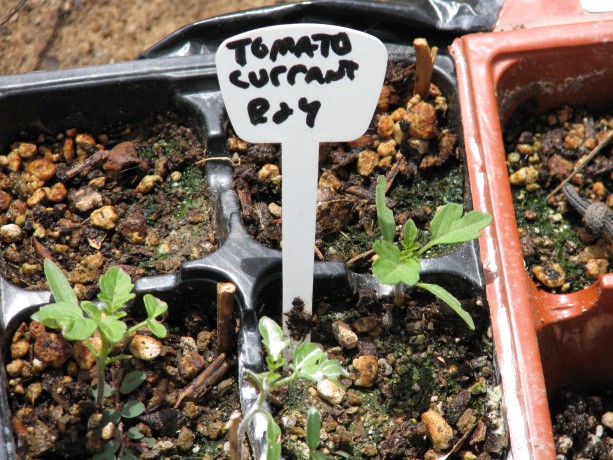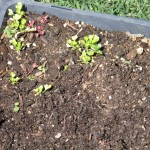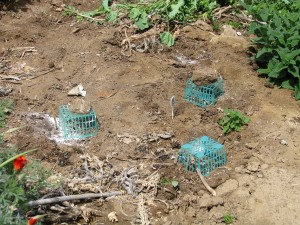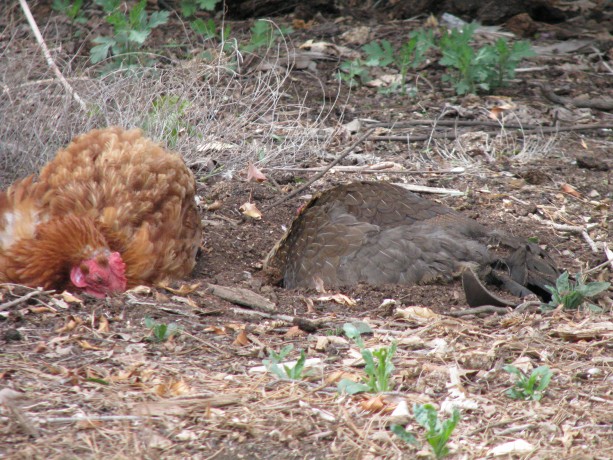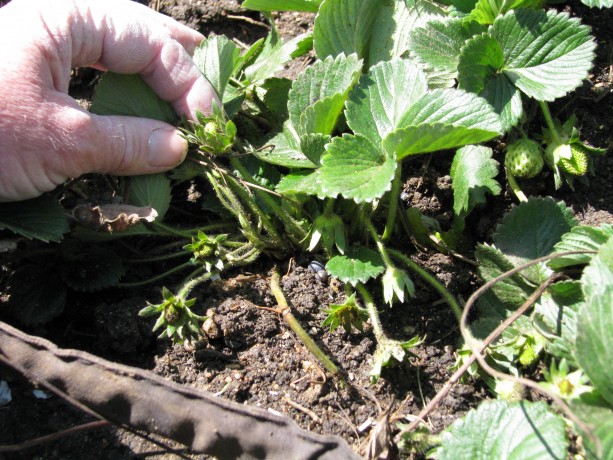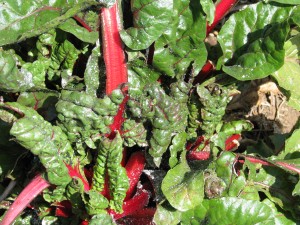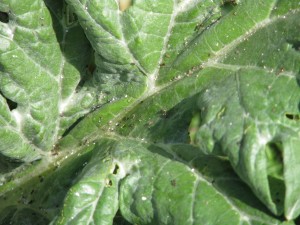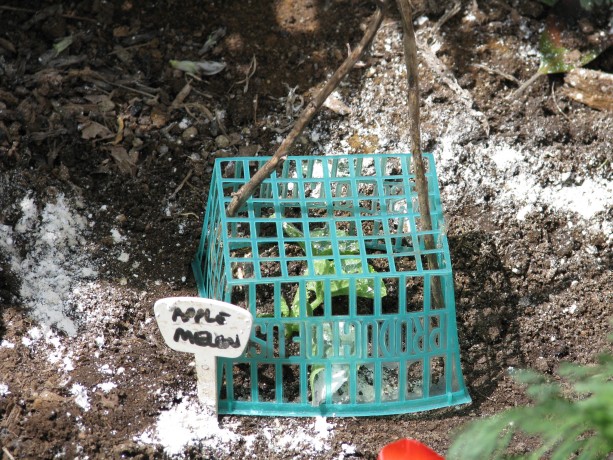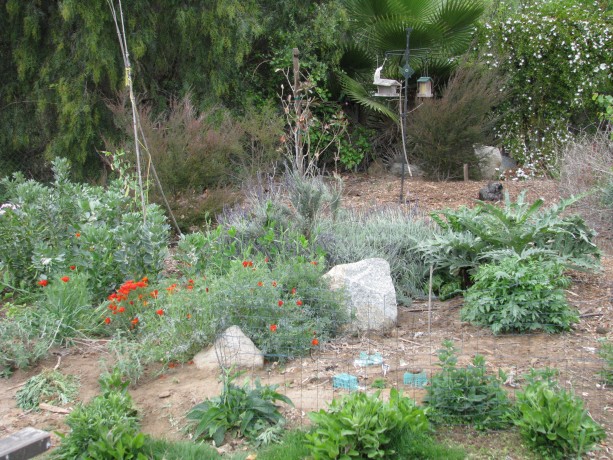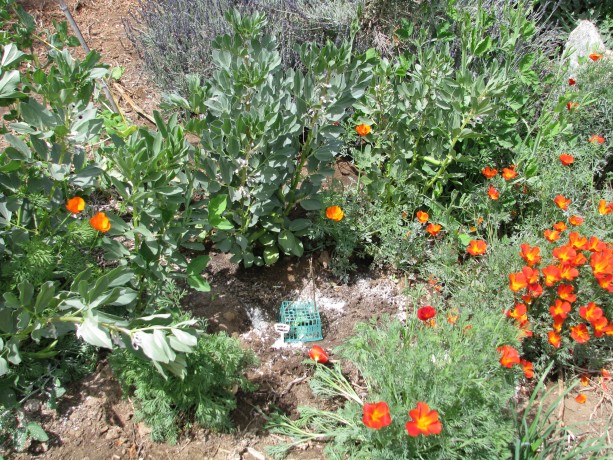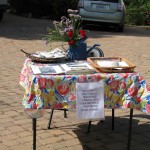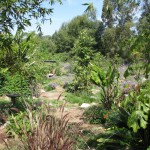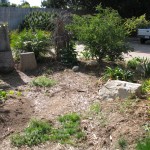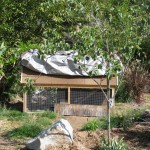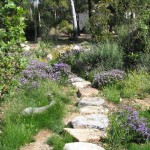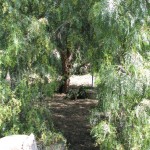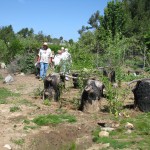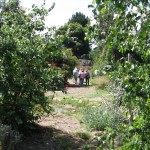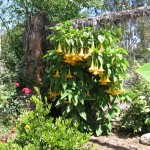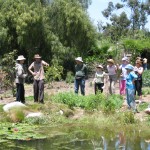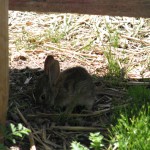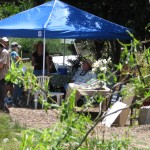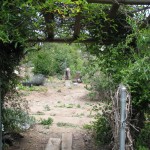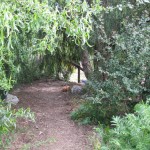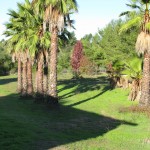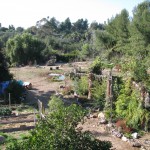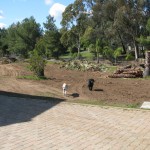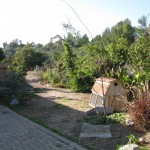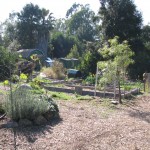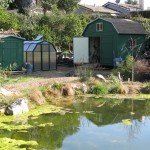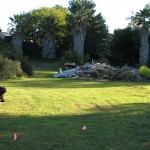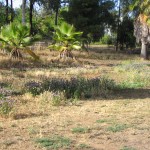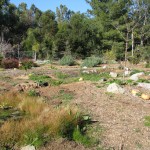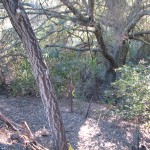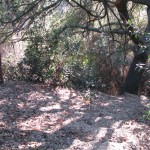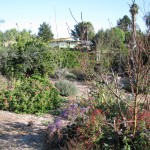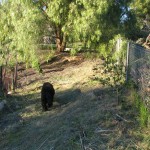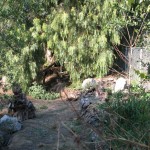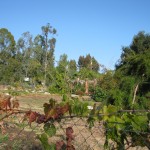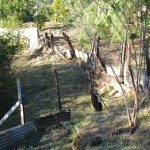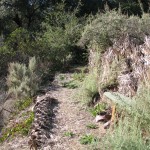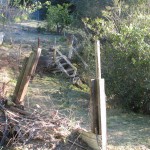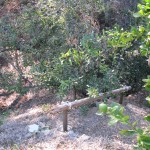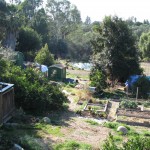- Animals, Bees, Birding, Chickens, Cob, Compost, Composting toilet, Fungus and Mushrooms, Gardening adventures, Health, Heirloom Plants, Hiking, Humor, Living structures, Natives, Natural cleaners, Other Insects, Permaculture and Edible Forest Gardening Adventures, Pets, Photos, Ponds, Predators, Quail, Rain Catching, Reptiles and Amphibians, Seeds, Soil, Water Saving, Worms
Finch Frolic Facebook!
Thanks to my daughter Miranda, our permaculture food forest habitat Finch Frolic Garden has a Facebook page. Miranda steadily feeds information onto the site, mostly about the creatures she’s discovering that have recently been attracted to our property. Lizards, chickens, web spinners and much more. If you are a Facebook aficionado, consider giving us a visit and ‘liking’ our page. Thanks!
- Animals, Chickens, Cob, Compost, Composting toilet, Fruit, Gardening adventures, Giving, Grains, Health, Herbs, Houses, Hugelkultur, Humor, Living structures, Natives, Natural cleaners, Permaculture and Edible Forest Gardening Adventures, Ponds, Rain Catching, Recipes, Seeds, Soil, Vegan, Vegetables, Vegetarian, Worms
San Diego Permaculture Convergence, Nov. 9 – 10, 2013
There is a fantastic, information-packed permaculture convergence coming up at the beautiful Sky Mountain Institute in Escondido.
 It will be two days packed with great information for a very reasonable price; in fact, scholarships are available. Check out the website at convergence@sdpermies.com. On that Sunday I’ll be teaching a workshop about why its so important to plant native plants, how to plant them in guilds using fishscale swales and mini-hugelkulturs. Come to the convergence and be inspired!
It will be two days packed with great information for a very reasonable price; in fact, scholarships are available. Check out the website at convergence@sdpermies.com. On that Sunday I’ll be teaching a workshop about why its so important to plant native plants, how to plant them in guilds using fishscale swales and mini-hugelkulturs. Come to the convergence and be inspired! -
Why Is July So Busy?
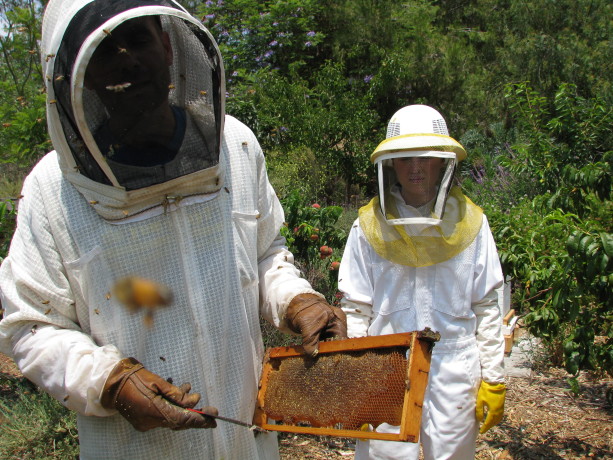
Quentin holds a frame full of wax-capped honey cells while Miranda looks on. Whew! What an early hot spell, and what a lot of things to do! The daylight is longer but animals, plants and people have a way of filling it all up. It is almost 9 pm again and still no dinner for humans this night. It is cooking. We’ve had a sick kitty, Maow, who we had to put to sleep due to kidney failure yesterday, and our ancient dog Sophie keeps us busy nursing her. She refuses dog food and only will eat veggie sausage and eggs, but none of our hens are laying in this hot weather. One of our chickens, Chickpea, had an egg break inside of her and had to have an Epsom salts warm sink bath which worked its chicken magic and pulled her through. Tonight our partially blind Rhode Island Red, Madge, has been acting funny so into the sink she went. The hens all like the warm bath so much that we don’t have to hold them down.
The garden produce has been good and keeping up with ripening fruit while beating the birds to it has been my newly graduated collegiate daughter’s role. Irrigation difficulties have created large problems, however, and lots of seeds never germinated, and several crops have shrivelled due to irregular or not enough water, while some others were drowning because of holes in the lines. Minerals from our hard water have clogged up holes in the lines, and running vinegar through the system seems to dissolve the calcium pretty well. If only it repelled the gophers who occasionally nip the underground lines, or the weeding tools that unerringly nick them.

Quentin and Miranda with one of the new hives of Italian bees put up two months ago. We have two co-op bee hives, set in place by Quentin Alexander of BeehiveSavers.com. He performs humane bee removal, and also has the co-op program where he sets up hives in your yard with calm Italian bees. You pay for the equipment, and he monitors the hive for a year to study the bees and see what is affecting the disappearance of European honeybees. He harvests the honey and gives you half of it, too. This is a perfect set-up for me since I just don’t have the time to deal with the bees anymore, and because I swell up when stung now. We had a swarm in a stack of empty bee boxes next to our trashcans for a couple of years and they never gave us any trouble, but I wanted to move them to the Bee Garden.

Quentin beginning to move a two-year hive that had settled in my stack of supers. The bees objected. When Quentin moved them a few months ago, he found out that they were an enormous ‘hot’ hive… pretty aggressive.
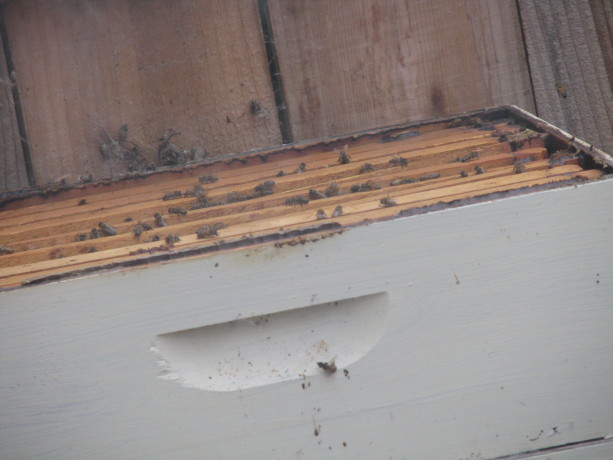
Bees complaining about having their home ripped apart… I can’t blame them. Yesterday he came with two ‘nuc’s, or ‘nucleuses’. A ‘nuc’ is a new queen bee and about a pound of workers devoted to her. With my daughter’s help, and with me hanging back with the camera, he opened the moved hive. It was breezy, humid, mid-day and in the 90’s, all bad conditions for opening a hive.
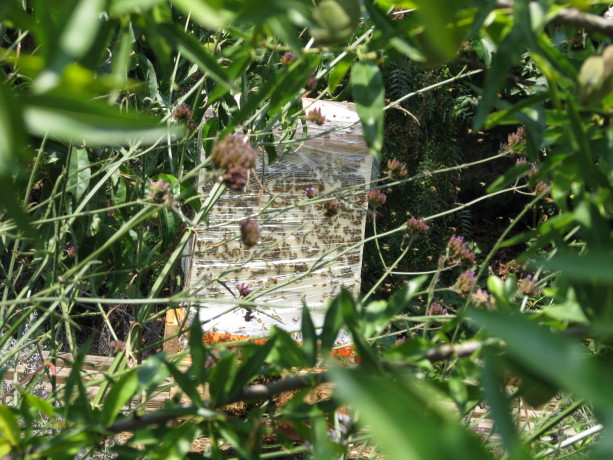
The wild hive wrapped with the ‘hot’ queen isolated in one of the supers by queen excluders. She will be replaced by a gentle queen. He looked for the old queen and couldn’t find her, so trapped her in one of the three boxes he thought she was in, moved honey and larvae over to two new boxes and set up the new queens. The idea is that the new kinder and gentler queens will breed more docile bees, and in a few weeks the whole swarm will not only have been divided into two but will have produced calm bees.
Explaining this to bees who were stressed from drought, heat, direct sunlight and humidity while tearing apart their hive, taking out brood and honey and looking to kill their queen, was a different story. A normal hive can have 60,000 bees or more in it at its peak. This was a larger hive. The bees decided that Quentin – and anyone else in the area – were going down with them. I don’t blame them. Attack my family and I’d come after you, too. Quentin’s gloves were studded brown with a forest of stingers. The neighbor called asking about bees because his gardeners were stung.
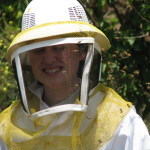
Miranda surrounded by very angry bees. No stings penetrated her bee suit, but on a humid day in the mid-90’s that suit sure was hot. We had to walk the property, roll in some jasmine to mask the ‘anger’ pheramone with which our bee suits were covered, and dash into the house. Quentin drove off in his suit with bees in his car – not an unusual sight for a beekeeper, but with the BeeHiveSavers logo on the side it looked very appropriate. We had to stay in the house until dusk when the bees went to bed (they don’t fly at night). Today the rest of the property was back to normal, but we did stay away from the Bee Garden for several more days. There are peaches to harvest in there, too, but we’ll have to donate some to the birds.
- Animals, Bees, Chickens, Gardening adventures, Other Insects, Permaculture and Edible Forest Gardening Adventures, Quail, Seeds, Soil, Vegetables
Protecting the Little Guys… and a little about diatomaceous earth
When transplanting little plants out into the big garden it feels like sending your child off to their first day at Kindergarten. All kinds of things can happen to them in the big world. For children… that’s too large a topic for me (Kindergarten mother survivor here). For plants I can give you some advice.
Besides watering too much or too little, and root disturbance while transplanting, little guys can be eaten by bugs, birds or other animals, or simply get lost and overlooked. (Here is a container growing tip: as your seedlings sprout and grow, gently pass your hand across them every time you are with them. It will make for stronger stems.) (And its fun!)(And you can pretend you’re ruffling their hair and say things like, “Hi, Sonny.” Or not.)
A day before transplanting out of a container or from a nursery bed, water the sprouts well. If they’ve been in containers for awhile those roots may be going in circles and the water can’t penetrate from the top very well. If that is the case, put the pots in water for half an hour until moisture is wicked into the pot thoroughly, then allow to drain. I say to do this the day before because if you water just before planting the soil around your root ball will fall apart, breaking fine hair roots and shocking your poor little guy. Some plants hate their roots being touched so much that this would kill them. By the next day after watering the container will still be moist, but the soil should be solid enough to stick together when tipped out.
Dig a hole twice as wide and twice as deep as your plant, then backfill with a mixture of good compost and the soil from the hole. This will help acclimate the roots to the soil change. Water the hole, and if you’re really industrious water with compost tea. Set your plant into the hole and firmly press the soil around the plant. If you are planting tomatoes, eggplant or peppers (all in the same family) you can set the plant more deeply into the hole; they will form more roots from the stems and become sturdier. The rule of thumb otherwise is to plant so that the soil level of the hole is the same as that of the transplant; many plants will rot if soil is up against their stem. If it is too low, the roots will be exposed and dry out. Potatoes can be trenches and hilled up as they grow, or maybe you will try trashcan or crate potatoes. If you live in an arid area, plant in shallows so that rain can accumulate around the plant. If you live in a wet area, plant on hills so water can drain off. Or if you’re practicing permaculture, plant on the swales!
So your little guy is in the ground and gently tamped in. To keep off the birds and bunnies and mice and rats and whatever else is looking for dinner, I use plastic berry cartons turned over and set in place with sticks or with rocks on top. Reuse and repurpose! They are also good for protecting figs . The cartons allow enough sun in, and also makes it very obvious where the seedling is so that you don’t step on it, or weed the little tomatoes out with the almost identical ragweed sprouts. For larger plants, turn over a milk crate.
I have no native quail in my yard. Due to nearby houseing developments, there aren’t many quail around me anymore. Quail would fill the niche of beetle and sowbug eaters. My hens want only worms, spoiled things, and their big feet do a lot of damage if not watched.
Sowbugs cluster under mulch and do damage to stems and fruit.
I use a little food-grade diatomaceous earth around the seedlings, new sprouts in the garden, around the strawberry plants, and also around plants such as artichoke, corn and chard where ants have begun to farm aphids.
I use it around the trunks of my stonefruit trees to stop the ants, and have been told that it works well around the legs of beehives in lieu of or in combination with cups of oil to keep out the ants. Diatomaceous earth is the finely ground bodies of ancient sea creatures (diatoms). The powder on a microscopic level is full of sharp edges.
When a sectioned insect such as an ant, flea or sowbug crawls on it, it rasps their tender areas and dessicates them. Not something I really am happy about doing to the bugs. I’m only using it on a very small scale. Remember that any insecticide, even DE, kills many kinds of insects not just the targets. You don’t want to eradicate your insects; most of them are helping your plants and your soil. DE will melt into the soil when watered, but only reapply if you still see the target bugs. The problem might already be taken care of.
Use food-grade DE, not the kind that is sold in pool supply stores. FGDE is used in graineries to keep weevils and other bugs out of grain and beans, so you’ve been eating it for years without knowing it. It doesn’t hurt us, nor is it bad to breathe (some people wear masks that they can get from https://accumed.com/n95-mask-for-sale-respirator-safety-face-mask-z1.html, just in case). It is a great, natural and inexpensive way to fight fleas without paying big money for poisons to put on your pet. I have it all over my cats’ bedding.
They sell DE sprayers, but they become clogged. The easiest and least expensive applicator (which can be repurposed)? A condiment dispenser. You know, the plastic mustard and ketchup squeeze bottles in diners. I bought a set of two for $2. You can practice a little to dispense a finer dust.
So I plant my little guys, give them a drink, squeeze a little DE around them, give them a berry basket hat until they outgrow it, then take it off to use elsewhere. If there is still a threat to your plants from critters (somebody was eating my eggplant leaves last year! I mean, really…ick!), then turn a wire gopher cage over the top or make a wire cage to fit and use sticks or landscape staples to fasten into the ground.. These, too, you can reuse yearly.
- Animals, Bees, Chickens, Cob, Compost, Composting toilet, Gardening adventures, Health, Heirloom Plants, Herbs, Natives, Permaculture and Edible Forest Gardening Adventures, Ponds, Rain Catching, Recipes, Salads, Soil, Vegan, Vegetables, Vegetarian, Worms
Southern California Permaculture Convergence! Be there!

Southern California Permaculture Convergence If you are interested in any aspect of permaculture, such as organic gardening, herbs, planting native plants, aquaponics, natural ponds, beekeeping, keeping chickens, and so much more, then you must come to the Southern California Permaculture Convergence. It happens on March 9th and 10th at the Sky Mountain Institute in Escondido. The keynote speaker will be Paul Wheaton, lecturer and permaculturalist extraordinaire of www.permies.com fame. Oh, and I’ll be one of the many speakers as well (cough cough). The Early Bird special of only $50 for both days ends at the end of January, and then the price will rise, so buy your tickets now!
Also, for a full-on demonstration of taking bare land and creating a permaculture garden, there will be a three-day intensive class taught by Paul Wheaton on site the three days prior to the Convergence.
You can read about the convergence here at the official website, which will give you the link perm.eventbrite.com where you may purchase tickets. Also visit the SD Permaculture Meetup page to see all the free workshops that happen monthly all over San Diego.
This convergence is such a deal, you really shouldn’t miss it! And such a bargain, too. One of the best things I find that come out of these convergences is the exchange of ideas and networking among the attendees, and all the practical information you can take home and use right away. One of the largest parts of permaculture is building community, which means sharing with and assisting others.
Really. Don’t miss this! Tell your friends!
- Animals, Bees, Birding, Chickens, Compost, Gardening adventures, Health, Other Insects, Permaculture and Edible Forest Gardening Adventures, Photos, Ponds, Quail, Rain Catching, Reptiles and Amphibians, Soil
I Went to a Garden Party….

AAUW Garden Tour Saturday was the AAUW Garden Tour. What a glorious day. I expected about a hundred visitors, and made 120 handouts. Sometime in the early afternoon I guess they ran out, and I didn’t know about it for awhile. I made 25 more for the last two hours, and have five left. One of the docents said that some had been turned back in during the morning. Every couple probably took just one… wow, that’s a lot of people.
I’d been talking to the garden all week, asking the blooming plants to hold that thought for a few more days, and encouraging the nonblooming ones to get a move on. The plants did what I asked! There were so many flowers out Saturday, it was amazing. Heirloom roses, Gideon’s Trumpet, ranunculus, herbs, wildflowers, and waterlilies. The garden, apparently, also was also all for proof in advertising, as in standing behind the NWF Habitat sign on the front gate. So many kinds of butterflies and dragonflies were out for the first time this year that people remarked on it. In the afternoon, there were sightings of a king snake all over the property; I think it had to have been three kingsnakes. One was moved from the refreshment area, but he came back, and then as I was standing by the pond talking to some ladies one came past us. Another was sighted up in the driveway. Roger sighted a gopher snake. No one shrieked or complained; either these were hardy people, or the idea that this was a habitat yard made them keep calm. It also backed up my claims of letting snakes deal with gophers and rodents! One man spotted a baby bunny under the Withy Hide bench. By one o’clock, it was funny. It was as if a button had been pressed to turn the garden on, and all the features were working! What a glorious day.
Jacob (Aquascape Associates) and Roger (landscape architect) and I answered questions for most of the day; the last four visitors left at four. So many people asked questions about permaculture, soil, beekeeping, cob ovens and rain catchment that I know that I couldn’t answer everyone’s questions. Of course there were some who like a tidy, orderly garden, and that is fine. If everyone came away with some idea how to work with nature rather against it, to use chemicals less, to grow organic food, to repurpose, to compost their kitchen waste and weeds, then what a lot of small ripples of good will come of it.
Thank you to my dear friends who helped prepare the garden so that it looked stunning. And thank you to the snakes, butterflies, bees, dragonflies, birds, bunnies and who-knows-what-else that came out to perform for the visitors! And thank you to everyone who visited! No casualities; all good.
Here are some photos, although my camera doesn’t do the colors justice:
AAUW Garden Tour Welcome! Look at photos of how it was. Main entrance walkway Walkway into the Nest One of the many trails A palm sitting stump between guilds by the driveway A green melon under variegated lemon, with native grasses. Quail hut, with privacy boards up. Status and wildflowers across the stone walkway Cool spot under the upper pepper tree Roger and visitors by the Withy Hide Some of the first visitors of many Pickerel blooming in the little pond Gideon’s Trumpet keeping blooms and aroma until the tour Jacob teaching about natural ponds Baby bunny under the Withy Hide bench Roger answering questions View from the Bee Garden gate Cool spot under the pepper tree - Animals, Bees, Gardening adventures, Other Insects, Permaculture and Edible Forest Gardening Adventures
Catching My First Bee Swarm
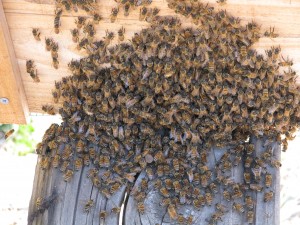 Today was warm but very windy, and I was stealing some time to work on trellises I’m building for the passionflower vines (another story for another time, and definitely for the humor section). The area I was working in was close to my house. Inside an enclosure for my trashcans there stands a stack of nine extra bee supers (or boxes). Last year a swarm moved in and I’ve let them stay since they were so happy (and had so much room!). I have a hive and two empty Top Bar hives down in my specially planted Bee Garden; why should a swarm go there when it can be near trashcans? So today I’m out there trying to unroll a roll of cattle wire without losing a finger, and I hear a loud buzzing. I looked up to see bees flying in ever widening circles around the trashcan enclosure. Normally they are in and out in a straight line (a honey flow) when gathering pollen. I wondered if they were being attacked or bothered by something because in my mind it is still early in the year. Then I remembered it is March already! The hive was swarming.
Today was warm but very windy, and I was stealing some time to work on trellises I’m building for the passionflower vines (another story for another time, and definitely for the humor section). The area I was working in was close to my house. Inside an enclosure for my trashcans there stands a stack of nine extra bee supers (or boxes). Last year a swarm moved in and I’ve let them stay since they were so happy (and had so much room!). I have a hive and two empty Top Bar hives down in my specially planted Bee Garden; why should a swarm go there when it can be near trashcans? So today I’m out there trying to unroll a roll of cattle wire without losing a finger, and I hear a loud buzzing. I looked up to see bees flying in ever widening circles around the trashcan enclosure. Normally they are in and out in a straight line (a honey flow) when gathering pollen. I wondered if they were being attacked or bothered by something because in my mind it is still early in the year. Then I remembered it is March already! The hive was swarming.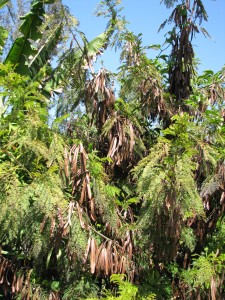
Can you see the swarm? Right in the middle. Just before a new queen hatches, the old queen takes a group of bees (depending upon the size of the hive, it could be 20,000 bees) to go find a new home. First they exit the hive and find a place to rest and reconnoiter. This is when people see them hanging from trees, underhangs, trashcans, whatever. Scouts are sent out to find a good place to stay. Sometimes they will stay where they are, even if it isn’t a good idea, such as the underside of a palm frond which a swarm built comb on for a short time some years ago in my yard. This swarm mercifully gathered in a guaje tree just opposite the enclosure.
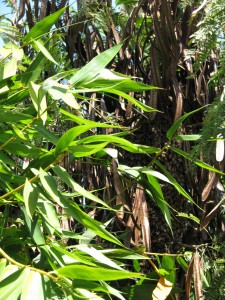
There they are. I let the wire go and realized how unprepared I was. I hadn’t completely finished preparing the bars for the top bar hives (so much to do!). My daughter and I have kept a hive for years. I really wanted that swarm, and although I’ve read about it and watched YouTube videos about it, just haven’t captured a wild swarm myself. I decided to try and get them.
First, I ran inside and rewatched a YouTube vlog on capturing a swarm, just to refresh my memory and boost my confidence. Then I ran down to the bee garden and prepared a top bar hive. I moved it to a better location, poured oil in the cups it sits in to keep out ants, and then finished preparing the bars. I’d serendipitously purchased craft sticks just yesterday ( a special stop at JoAnns), and I rubbed old wax into the grooves to make the craft sticks stick. Top bar hives have no foundation like Langstroth hives. The bees are encouraged to build their own comb, using the bit of craft stick hanging down from the bars as a guide. This is a healthier way to for bees to live when captured. Then I dropped a few drops of lemongrass oil into the hive; bees really like it and are attracted to it. I also smeared a little organic honey inside for some instant food. This sounds so smoothly done, but actually there were a dozen trips between the bee garden at the bottom of the property, the house, the shed and the swarm, all done in a crazed, frantic and nervous sort of way. A mad woman. Again I’m grateful for good neighbors.

Top bar hive, with craft sticks waxed onto the underside of a bar. I suited up in full bee gear. Many people catch swarms without protective gear, or with just a veil. When bees swarm they are the least likely to attack because they aren’t defending a hive. They are clustering around their queen, not wanting to be separated from her. However, since I now swell up dramatically when stung, I decided to take no chances.
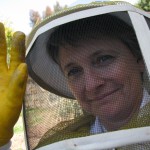
Hi. Fortunately the bees weren’t high up. I dragged out a stepladder and found a smallish cardboard box.
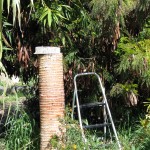
Fortunately within easy reach of a stepladder. Standing on the ladder and shoving the box under the swarm, I shook the branch, knocking the bees into the box. When I thought I had most of them, I carried the box, full of crawling bees, down to the hive. I wish I could have taken a photo, but with the thousands of bees in the box I didn’t want to go get the camera and fumble with it with my gloves; I didn’t want to hurt any of the girls and they needed to be relocated before they took flight. I shook the box into the open top of the hive, and then put the top bar lid on. There were still bees back on the tree. I didn’t see the queen, and I really needed to make sure I got her. I shook in the rest of the bees and then carried them back down to the bee garden.

I shook the cardboard box of bees onto the ramp. I didn’t want to open the hive again, so I propped a board up to the entrance holes, then shook the box of bees out onto the ramp. Bees will climb, and climb they did. I used a bee brush to carefully collect bees that had clung to the outsides of the hive, and dumped them on the ramp, too. There was quite a traffic jam for awhile.
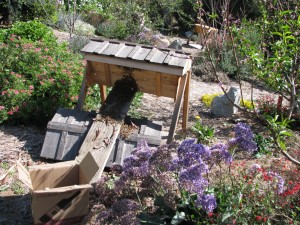
Traffic jam of bees climbing up the ramp into the opening. Eventually all the bees were in. I removed the ramp and cleaned up… not a sting. Actually, once I first climbed the stepladder I felt and heard the lack of anger in the swarm. They weren’t making a high-pitched angry buzzing noise. Tradition has it that you should talk to your bees; make sure to tell them about any change in the household. So I talked to them as I transported them down to what would hopefully be their new home. Just before dark I rapped once on the side of the hive and all 10- or 20-thousand of them hummed at me. If I got the queen and they are happy, then they will stay. Otherwise they’ll swarm again. No bees were harmed, and the few left up by the tree wondering where the old queen went were close enough to the old hive to go back, and make their allegiance to the new queen.

Almost all in. 
The girls are spraying pheromones to mark their location. I came inside feeling good about gently relocating them, and had some dark chocolate to settle my nerves! Then I went on to wrangle with the wire and the trellises, which was far more trouble than moving a swarm of bees.
- Animals, Bees, Birding, Chickens, Gardening adventures, Heirloom Plants, Other Insects, Permaculture and Edible Forest Gardening Adventures, Photos, Ponds, Rain Catching, Vegan, Vegetables, Vegetarian
Garden’s One Year Anniversary
Happy Anniversary! One year ago on Feb. 1, 2011, I signed a contract with landscape architect Roger Boddaert (760-728-4297) to create a permaculture garden. For twelve years I’ve had this sloping property that was covered in weeds and worthless Washingtonia palms. Not only do these 2 acres slope down to a barranca, but it was filled in due to catching all the rainwater that runs from the street and properties above. I have to give credit to friend Gary B., who brought up the subject of permaculture in a conversation the year before. I’d heard the term and thought I knew what it was about, but months later when I was researching what to do with my property I remembered him mentioning it, and looked it up. I found what I was looking for. I’ve been an organic gardener for many years, have owned chickens for their eggs, have refused to till the soil so as not to kill microbes, have worked naturally with animals and plants, have created habitat, composted, recycled, collected rainwater… and all of that was permaculture. And so much more. How can one not be attracted to the term Food Forest? Certainly not a foodie and gardener like myself.
What happened on the property starting the week of Feb. 1 for the next six months altered the land so that it is truly two acres of habitat. It is useful, it is natural, and it is beautiful. Roger’s team led by Juan built beautiful walls of urbanite, planted and hauled, worked in scorching sun and frosty mornings and made what was dreamed into reality. An integral part of the garden has been diverting the water from erosion points and into rain catchment basins and natural ponds, and that is where Aart DeVos and Jacob Hatch of Aquascape (760-917-7457) came in. They also installed the irrigation. Dan Barnes did the rough and the precise tractor work (760-731-0985) and I can’t recommend his experience and skill enough. Fain Drilling dug the well (760-522-7419) and the wonderful sheds were built by Quality Sheds of Menifee (http://www.socalsheds.com) .
Along with some volunteer help from Jacob, I am the sole caretaker of the property. I am planning the plant guilds, weeding, improving soil, moving problem plants and trees and, did I mention, weed? Oh yes, then there is weeding. On Saturday May 12th, the garden will be on the Garden Tour of the Association of University Women of Fallbrook, and hopefully many people will be inspired to go organic, to create habitat, conserve water and grow extra food for the Fallbrook Food Pantry. We’ve come a long way, baby!
The following photos are comparisons between the precise location last year at this time, and today.
The property last February. The property today. Sophie and General loved all the excitement. They love the new gardens and pond even more. My veggie beds with the old sheds behind. My veggie beds with the new sheds and greenhouse behind. Where the big sheds were: everything usable was reused. New sheds that aren’t a safety hazard, and the greenhouse. The lower area with shed debris (lots of mowing area!). Hey, there are ponds there now! Not much for the neighbors to look at. Quite a lot for the neighbors to look at! Access to the old oak was hazardous. Palm stairs lead past the oak to a birding area. Stonefruit were old when I moved in. New stonefruit adorn what is now the Bee Garden. An erosion area sloping down to the barranca. Water won’t flow through here anymore. Lots of mowing and palm frond removal. Not so anymore. Horrible looking debris failed to hold back the embankment. Palms were used to stabilize the new paths and camoflage the supports. Old unstable stairs led to washout areas. New railings, stairs and urbanite retaining walls lead to another viewing area. The view from my balcony. Part of the old shed remains. Hey, there’s a pond there! - Bees, Chickens, Gardening adventures, Other Insects, Permaculture and Edible Forest Gardening Adventures, Vegetables
Crazy-Pot Seeds
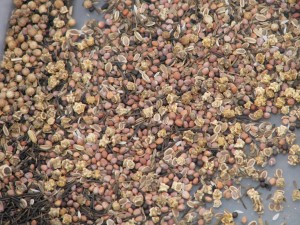
Crazy-pot mixture of veg seeds Today, the palindromic 11/11/11, was also Veteren’s Day and a day between two rainy weekends. A perfect day for spreading lots of seeds. With winter rains on their way in a month, it is important to hold the topsoil with rooted plants, and why not use a cover crop that also fixes nitrogen? My choices were hairy vetch and a tall native lupine.
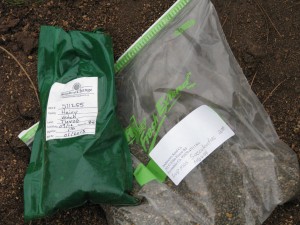
Native lupine and hairy vetch seeds I would also have liked to use white or sweet clover but sources were sold out early this year. Both my choices will have flowers that offer plenty of nectar to bees, be lovely, hold the soil, set nitrogen, and can be, if needed, sacrificed. When you ‘sacrifice’ a nitrogen-fixer, you can either turn it under or cut the tops, leaving them in place on the soil surface to decompose.
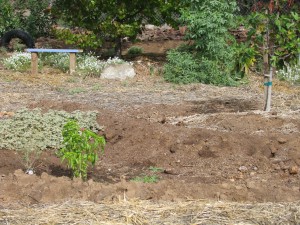
Plant guild waiting for seeds I don’t agree with disturbing my soil microbes any more than necessary, so I won’t be tilling ever again. When you cut a nitrogen-fixer, the roots release the nitrogen they hold into the soil as the tops mulch then decompose bringing lots of nutrition to the soil surface. Vetch should be a winter crop, and lupine a spring crop, if they can tell the difference here in San Diego!
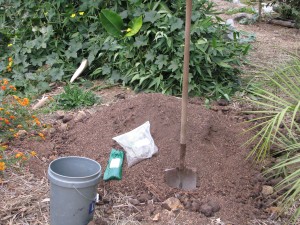
Mixing seeds with mushroom compost My method for spreading these two was to mix handfuls of each with a bucket of mushroom compost, and hand spread it in the most bare and most unfertile areas.

Broadcasting lupine and vetch seeds mixed with compost Adding the compost, I thought, helped the seed distribute more evenly, gave it a little cover since I wasn’t going to rake it in, and disguised it from birds a little.
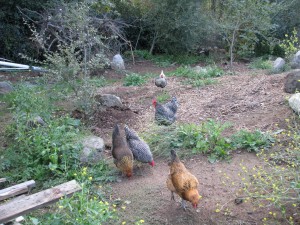
The girls. Once done, I decided it was also a good time to do something I had been looking forward to doing for years: spreading old veggie seeds. I’d done a little of this in a raised veggie bed, with some success. I have so many old packets of veggie seeds that I’m not going to use in the raised beds (I have all organic seed now), and I can’t believe that it isn’t viable. If they sprout seeds found in ancient Egyptian tombs, then I’m sure mine can sprout, too. This seeding is a very important step in the edible forest garden.
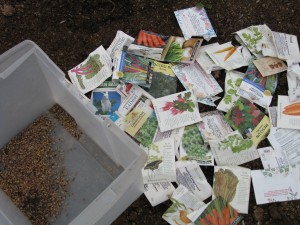
Many old winter crop seeds This year’s abundance of herbs, squash and tomatoes has been fabulous… I still have some ‘feral’ tomatoes putting on enormous fruit which I pick, polish and eat out of hand in the garden while I’m working.
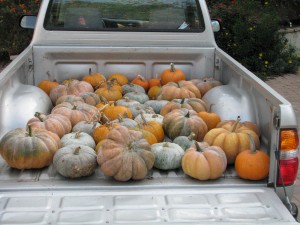
Pumpkins and squash on their way to the Fallbrook Food Pantry I opened all the packages of seed for cool-weather vegetables, such as carrots, radish, dill, broccoli rabe, and lettuces. Some such as garlic chives and onion I separated out and sprinkled near roses, since alliums are a companion plant for roses and help ward away aphids. The rest of it was mixed up in a lovely crazy-pot of seeds. I didn’t mix with compost this time, as there were fewer and smaller seeds involved. I sprinkled them then covered them with soil using my foot… the professional way to plant!
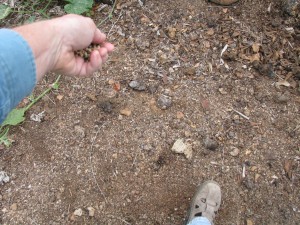
Scattering veggie seeds I am eager to see what comes up after the rain this weekend. It truely will be an edible landscape. Even if I allow the veggies to go to seed, the blooms will all be excellent bee food sources, especially the carrots and dill. None of these were nitrogen-fixers, because I used all the extra peas up in the vegetable beds this spring (see archives) improving the soil. Beans, and other warmer-weather seeds I’m holding back for February or March planting. I do have sweetpea seeds to plant out, but the lupine and vetch will be working their magic anyway.

Embankment with ragweed, now seeded with lupine and vetch 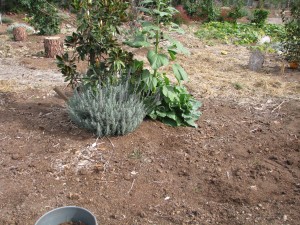
Under the soil is now daffodil bulbs, lupines, vetch and mixed vegetable seeds About ten years ago I had a short story published in the young person’s magazine Cricket called Taking Tea with Aunt Kate. In it a girl lived with her mother who was a wild, messy gardener, spreading seeds all together and having veggies and flowers mingling in riots of color. The girl’s aunt is, by contrast, perfectly coiffed and takes her to a formal ‘high tea’ at a prestigious restaurant. The girl decides that she can be a little of each woman, a little wild and a little formal. I think I’m that child! I clean the dirt out from under my nails so that I can go to the opera.
I’ll be walking the garden in the next few weeks, waiting for tell-tale sprouts (and trying to figure out if they are weeds or not!), and watching the bare areas come to life. How fun!
- Bees, Gardening adventures, Other Insects, Permaculture and Edible Forest Gardening Adventures, Vegetables
Nitrogen-Fixing Plants
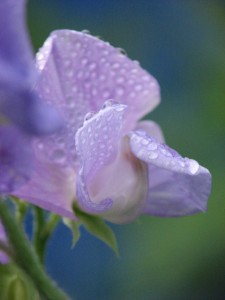
Sweet pea If you’ve read my posts from this spring, you’ll have endured me going on and on about peas and beans and how they fix nitrogen in the soil. For those who nodded off during those episodes or who have just tuned in, I’ll go over it briefly.
Some plants have the ability to fix nitrogen in the soil. Actually, a type of bacteria called a rhizobia invades the roots of plants in the Fabacea family and a few others, and fixes atmospheric nitrogen in nodules on the plant’s roots. This is beneficial to both the plant and the bacteria, a process called mutulism. It also benefits whatever grows around the plants because, when the plant dies, the nodules release their nitrogen into the surrounding soil. In the case of long-lived shrubs and trees that fix nitrogen, as roots die off or are replaced, they release their nitrogen.
An edible forest garden is one where man mimicks the dynamics of an old-growth forest. Why? Because forests succeed without the aid of fertilizer, tilling, mulching, irrigation or any interference or ‘help’, as it were, from man. How does it do this? The plants that grow complement each other, providing what each other needs. These relationships are called plant guilds. You can create plant guilds, substituting plants that provide food for humans. In a guild there is a taller tree which provides shade and leaf droppings (mulch), shrubs which provide more shade, mulch and habitat for animals and insects, plants that fix nitrogen in the soil, plants that have long tap roots called ‘miner’ plants, because they take up nutrients from deep in the soil and deposit them on the soil surface when their leaves die off, plants that attract pollinators, and plants that are ground covers to regulate heat and moisture. Using permaculture practices for water harvesting and organic gardening, when the guild matures it should be almost completely self-sustaining.
Say you want to plant an apple tree. That would be your tall canopy tree for the guild, which drops leaves as mulch. Beneath it, you could plant a shrubby herb such as rosemary (another edible), daikon radishes (miners, leaving the cut leaves on the surface after harvesting the edible root), bush beans (legumes) and herbs such as dill, parsley and basil, some of which you allow to flower for pollinators. As the tree grows, the plant guild can widen and others planted.
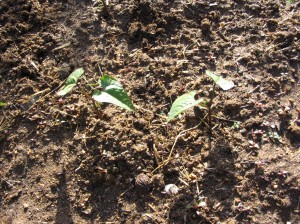
Beans There are many plants, trees and shrubs that fix nitrogen in the soil. All beans and peas including soybeans and fava beans do; when the plants are finished cut them above the soil so the roots stay put and decay where they are to release the nitrogen. Cover crops such as clover and hairy vetch are grown and turned under to improve the nitrogen in the soil. If you are from the Southern California area, perhaps you’d be interested in knowing what native plants are nitrogen fixers.

Ceanothus (California Lilac) at Elfin Forest The native Southern California nitrogen fixers include: ceanothus, lupine, deerweed, California peashrub (endangered) (lotus), and redbud. Non-natives that are commonly used are alders, acacias, calliandra, sweet peas, guaja, and many more, as the Fabacea family is very large. Use any of the natives in ornamental gardens and not only will you be improving the soil and the vigor of the surrounding plants, but providing much needed habitat for our native birds and insects.
Try building plant guilds; it is challenging and fun. Many combinations of plants are suggested on permaculture

